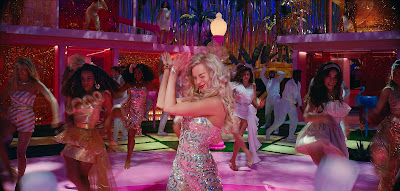Oppenheimer is a historical epic that largely keeps the epic off screen.The war is raging, but we don’t see it. High level conversations are happening, and we only sometimes hear pieces of them. Bold-faced names walk through, but as just a string of colleagues, allies, and foils. Its enormity comes from our, and their, understanding of its title figure’s accomplishments, and how the ramifications continue to reverberate. This is all about character—how one man moves through his life and, one step after another, brings about the possibility to destroy the world in an instant. That’s heavy. The film is written and directed by Christopher Nolan, who is good at affecting a popcorn seriousness. His films—Inception, Interstellar, The Dark Knight, a list of some of the more imposing blockbuster efforts in recent memory—move with portent, images that land with sturdy thuds and soundscapes that simmer and tremble and rumble. He makes enveloping moods of iced surface sensation, vice-twisting tension, and looming doom. For this new movie, he’s found a subject beyond space, beyond comic books, beyond sci-fi conceits that lets his skills expand into tough terrain that matches his moods. Like Dunkirk, his other film set during World War II, Oppenheimer is seriously serious. But unlike that movie’s relentless action focus on combat and survival, this is a brooding character piece through which the fate of mankind runs, and as such carries within it a heaviness that accumulates until the entire weight of the three hour runtime lands so hard in its finality that its effect is hard to shake. The movie, like the man at its center, looks upon his mighty works and despairs.
Nolan’s approach—a cold-to-the-touch sentimentalism, or sweeping high-concept pessimism shot through with messy stuff of human feeling—is here comparable to David Lean’s epics. Like Lawrence of Arabia, we can find in this new picture a vivid historical recreation writ large and small—major, world-shaping events that flow through the intimate experiences of specific people. Here, with Oppenheimer, we see a man whose scientific brilliance got him the job of overseeing the creation of the atomic bomb. Nolan sometimes fills the screen with cutaways to swirling electrons, arcing sparks, water drops and ripples. We get the sense the film, like its subject, can see to the whirling atomic heart of things, past the illusion of so many molecules tricking us into thinking we are on solid ground. Cillian Murphy plays Oppenheimer with a casual confidence in his intellect. He struts around deep into his theories, but struggles with putting them into practice. He’s willing to let others check the math and do the lab work. Though a womanizer—both his wife (Emily Blunt) and mistress (Florence Pugh) are drawn into his off-kilter charisma—and able to talk his way into contact with all the top scientific minds of his time from Heisenberg to Bohrs to Einstein, he can also be grindingly aloof, and unaware of interpersonal graces. He wants to sink into the deeper philosophical heart of science. That explains how haunted his gaze grows, as the implications of his ideas’ practical import grow all the more tangible as they escape his mind and enter the world.
In short scenes and snappy exchanges lensed with vivd filmic tones and chilly glow by Hoyte van Hoytema, and set against a Ludwig Göransson score in constant motion, we see a career on the rise. Oppenheimer’s academic work is on a collision course with a war, and a need to press his research into militaristic utility. There’s momentum hurtling things along, even as we see his personal entanglements—affairs, insults, Communist meetings—are vulnerabilities that may come back to haunt him professionally and emotionally. As his talents are requisitioned by the United States government, represented primarily by a no-nonsense general played by Matt Damon, a secret desert laboratory is assembled along with a team of the nation’s top scientific minds (a cornucopia of character actors at their best, recognizable faces that serve as quick-flash characterization and memory aid to hold onto in the lengthy swirl of activity). The movie picks up even more urgency from its propulsive process there. It’s behind-the-scenes of a bomb, with trial and error and jangling nerves from competing egos and ideas. The enormity of their project’s consequences is ever-present. There’s incredible tension on all sides. They feel they must succeed at all costs. And yet, what is that cost?
Adding to the sense of hindsight, and sorrowful retrospection, is the structure. We see the story flashing back from two post-war times: in color, Oppenheimer’s attempt to renew his security clearance, and, in black and white, a Senate hearing considering for a prospective cabinet position a bureaucrat (Robert Downey Jr) who clashed with Oppenheimer. Their responses to official questions guide us into the story of the bomb’s creation, a long, clear-eyed swirl of small roles and vivid impressions culminating in a fearsome test sequence. Nolan stages several heart-stopping moments, with bomb tests and other concussive effects masterfully manipulated sound and fury. But the fire and brimstone filter into other moments as well, as the film’s period piece pleasures of documents and interrogations and tense debates are filtered through the subjective perspectives—nightmarish sequences of fearful visions, quick flashes of paranoid suspicions or haunted memories mixed in with the forward momentum of historical reenactments’ inevitabilities and the scientific method’s rigid mix of theory and practice. It’s a movie about chain reactions, both the atomic forces unleashed by Oppenheimer’s work, and also the politics and people who collide and combine to form our world, or destroy it.



